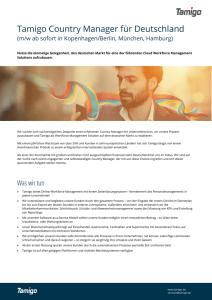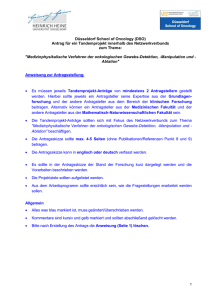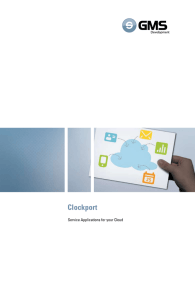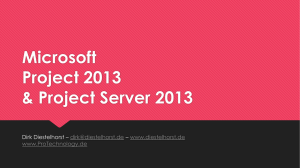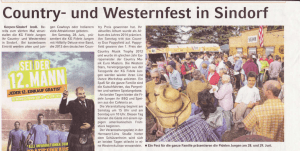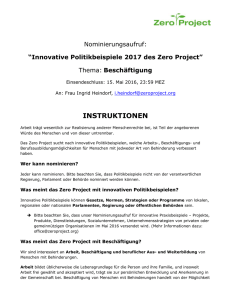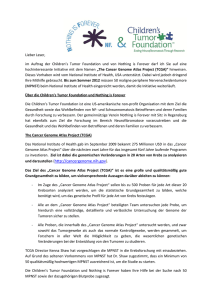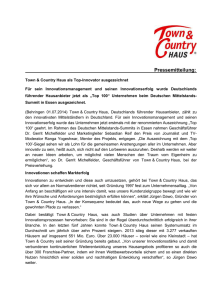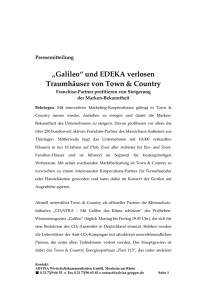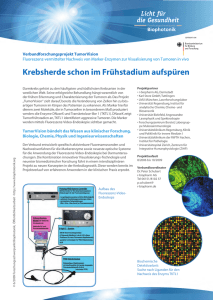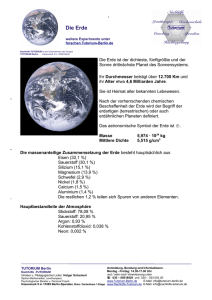DOC - Europa.eu
Werbung
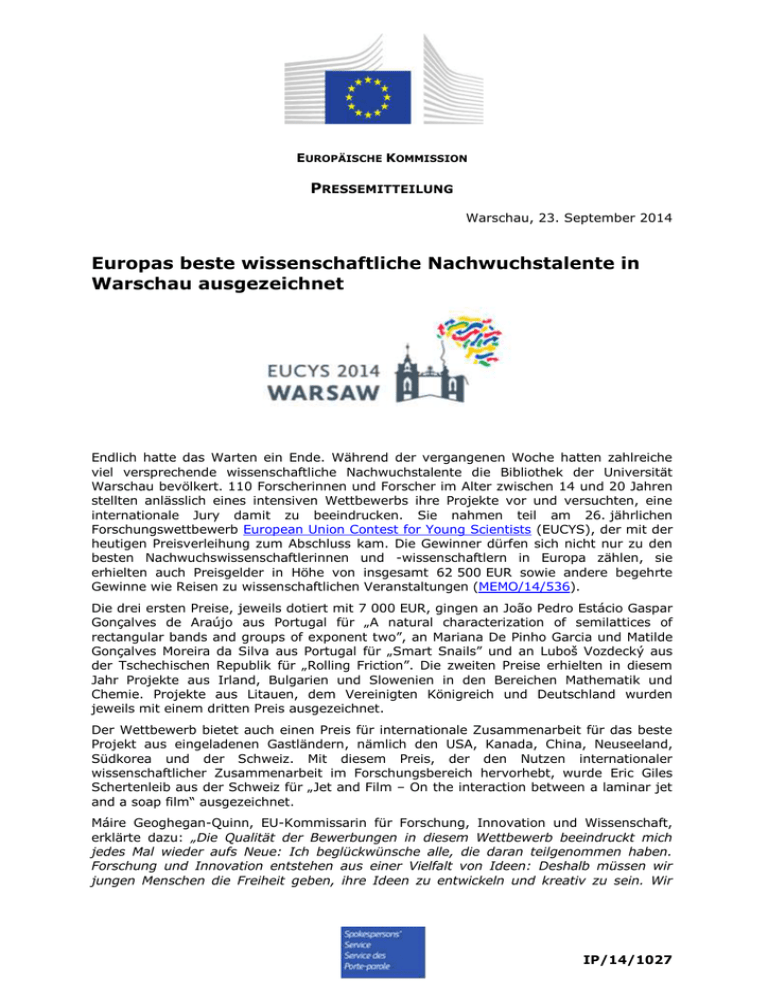
EUROPÄISCHE KOMMISSION PRESSEMITTEILUNG Warschau, 23. September 2014 Europas beste wissenschaftliche Nachwuchstalente in Warschau ausgezeichnet Endlich hatte das Warten ein Ende. Während der vergangenen Woche hatten zahlreiche viel versprechende wissenschaftliche Nachwuchstalente die Bibliothek der Universität Warschau bevölkert. 110 Forscherinnen und Forscher im Alter zwischen 14 und 20 Jahren stellten anlässlich eines intensiven Wettbewerbs ihre Projekte vor und versuchten, eine internationale Jury damit zu beeindrucken. Sie nahmen teil am 26. jährlichen Forschungswettbewerb European Union Contest for Young Scientists (EUCYS), der mit der heutigen Preisverleihung zum Abschluss kam. Die Gewinner dürfen sich nicht nur zu den besten Nachwuchswissenschaftlerinnen und -wissenschaftlern in Europa zählen, sie erhielten auch Preisgelder in Höhe von insgesamt 62 500 EUR sowie andere begehrte Gewinne wie Reisen zu wissenschaftlichen Veranstaltungen (MEMO/14/536). Die drei ersten Preise, jeweils dotiert mit 7 000 EUR, gingen an João Pedro Estácio Gaspar Gonçalves de Araújo aus Portugal für „A natural characterization of semilattices of rectangular bands and groups of exponent two”, an Mariana De Pinho Garcia und Matilde Gonçalves Moreira da Silva aus Portugal für „Smart Snails” und an Luboš Vozdecký aus der Tschechischen Republik für „Rolling Friction”. Die zweiten Preise erhielten in diesem Jahr Projekte aus Irland, Bulgarien und Slowenien in den Bereichen Mathematik und Chemie. Projekte aus Litauen, dem Vereinigten Königreich und Deutschland wurden jeweils mit einem dritten Preis ausgezeichnet. Der Wettbewerb bietet auch einen Preis für internationale Zusammenarbeit für das beste Projekt aus eingeladenen Gastländern, nämlich den USA, Kanada, China, Neuseeland, Südkorea und der Schweiz. Mit diesem Preis, der den Nutzen internationaler wissenschaftlicher Zusammenarbeit im Forschungsbereich hervorhebt, wurde Eric Giles Schertenleib aus der Schweiz für „Jet and Film – On the interaction between a laminar jet and a soap film“ ausgezeichnet. Máire Geoghegan-Quinn, EU-Kommissarin für Forschung, Innovation und Wissenschaft, erklärte dazu: „Die Qualität der Bewerbungen in diesem Wettbewerb beeindruckt mich jedes Mal wieder aufs Neue: Ich beglückwünsche alle, die daran teilgenommen haben. Forschung und Innovation entstehen aus einer Vielfalt von Ideen: Deshalb müssen wir jungen Menschen die Freiheit geben, ihre Ideen zu entwickeln und kreativ zu sein. Wir IP/14/1027 müssen uns auch noch stärker dafür einsetzen, dass sich mehr Frauen für Wissenschaft und Technik begeistern. Das sind echte Herausforderungen für unsere Bildungssysteme.“ Bei dem Wettbewerb in Warschau waren 77 Projekte aus 36 Ländern vertreten (EUMitgliedstaaten, assoziierte Staaten und andere Länder). Alle Projekte waren bereits in den nationalen Ausscheidungen mit dem ersten Preis der jeweiligen Fachrichtung bedacht worden. Sie decken ein breites Spektrum wissenschaftlicher Bereiche ab: Biologie, Physik, Chemie, Informatik, Sozialwissenschaften, Umwelt, Mathematik, Werkstoffe, Technik und Medizin. Vorsitzender der diesjährigen Jury war Dr. Henrik Aronsson von der Universität Göteborg. Die Jury selbst bestand aus 18 internationalen Experten der verschiedenen wissenschaftlichen Bereiche. Hintergrund Der EU-Wettbewerb für Nachwuchswissenschaftler wurde 1989 von der Europäischen Kommission ins Leben gerufen, um die Zusammenarbeit und den Austausch zwischen jungen Wissenschaftlerinnen und -wissenschaftlern zu erleichtern und ihnen die Möglichkeit zu geben, sich von einigen der bedeutendsten Forscherinnen und Forschern in Europa beraten zu lassen. Der erste Wettbewerb fand in Brüssel statt, seither wurde die Veranstaltung in 24 europäischen Städten ausgerichtet. Mit dem Wettbewerb sollen die Bemühungen der Teilnehmerländer unterstützt werden, junge Menschen für das Studium so genannter MINT-Fächer (Mathematik, Ingenieur/Naturwissenschaften und Technologie) zu interessieren und dazu zu bringen, berufliche Laufbahnen in Wissenschaft und Forschung einzuschlagen. Die Zahl der teilnehmenden Nachwuchsforscherinnen und -forscher ist von 59 im ersten Jahr (1989) auf 110 in diesem Jahr gestiegen. Ein Rekord wurde 2009 in Paris mit 137 Wettbewerbern erzielt. Frühere Preisträger haben angesehene Laufbahnen in der Forschung eingeschlagen, beispielsweise bei der Europäischen Weltraumorganisation (ESA) und dem CERN. Einer der diesjährigen Preisträger der Fields-Medaille, Professor Martin Hairer, hatte beim Wettbewerb von 1991 einen Preis gewonnen. Das allgemeine Problem weiblicher Unterrepräsentation in den MINT-Fächern spiegelt sich auch in der Zahl der Frauen unter den Wettbewerbsteilnehmern wider. In diesem Jahr lag ihr Anteil bei 37 % (41 gegenüber 69 männlichen Teilnehmern). 1997 überstieg der Frauenanteil erstmals 30 %; seither bewegt er sich in der Regel zwischen 30 % und 35 %, wobei 2005 ein Höchstwert von 41 % erreicht wurde. In den vergangenen 26 Jahren wurden 183 junge Frauen und 614 junge Männer mit Preisen ausgezeichnet. Ausführliche Angaben zum diesjährigen Wettbewerb finden Sie unter: http://media.eucys2014.pl. Alle drei ersten Preise sind mit 7000 EUR dotiert, während die Teams an zweiter und dritter Stelle jeweils 5000 EUR bzw. 3500 EUR erhalten. Weitere Preise sind Reisen zum International Youth Science Forum in London sowie zum International Youth Science Seminar in Stockholm. Darüber hinaus gibt es Preise von Sponsoren aus der Wirtschaft (u. a. Reisen zur Wissenschaftsmesse Intel ISEF in den USA) sowie von der Gemeinsamen Forschungsstelle der Europäischen Kommission, der Vereinigung europäischer Forschungsorganisationen EIROforum und dem Europäischen Patentamt. Weitere Informationen über den Wettbewerb und die Preisträger unter: http://ec.europa.eu/research/youngscientists/index_en.cfm 2 Kontakt: Michael Jennings (+32 229-63388) Twitter: @ECSpokesScience Monika Wcislo (+32 229-55604) 3 ANNEX 1 Prize-winners 26th European Union Contest for Young Scientists A. CORE PRIZES Three first prizes (€7 000 per project) Country: Portugal Contestant: João Pedro Estácio Gaspar Gonçalves de Araújo (16) Field: Mathematics Project title: A natural characterization of semilattices of rectangular bands and groups of exponent two Abstract: In a recent paper, R. A. R. Monzo characterized semilattices of rectangular bands and groups of exponent 2. However, his characterization does not point directly to the properties of rectangular bands and groups of exponent 2 (namely, idempotency and commutativity). My work consisted in proving a natural characterization of this type of semillatice. Country: Portugal Contestants: Mariana De Pinho Garcia (16) and Matilde Gonçalves Moreira da Silva (16) Field: Biology Project title: Smart Snails Abstract: The development of a chronic mollusc toxicity test is currently a work item on the agenda of the OECD. We report the improvement and standardization of a toxicity bioassay using eggs of the great pond water snail Lymnaea stagnalis L., which have a biological indicator of water pollutants. We optimized both isolation and synchronization methods to reduce variability, and identified sensitive developmental stages and parameters to assess the putative toxicological effects (i.e. heartbeat, period of development, hatching success, mortality and movement). Our work is an invaluable advancement to develop a reliable, fast and inexpensive environmental embryo toxicity test for molluscan species. Country: Czech Republic Contestant: Luboš Vozdecký (19) Field: Physics Project title: Rolling Friction Abstract: There are many theories in books or on the Internet, each of which describes rolling friction in a different way. The basic idea that is used in almost all theories is that the deformations of underlay cause a force which we observe as rolling friction. Some theories claim that there is a bulge formed in front of the rolling body and this bulge is supposed to cause rolling friction. Although there are no experiments that would either confirm or disprove the theory, this theory seems to be generally accepted. The aim of this work is to design and do an experiment that would capture the deformations of an underlay under a rolling body and that would afterwards either confirm or disprove the theories described above. Another aim of this work is to introduce a theory that would describe the origin of rolling friction and that would correspond to the performed experiments. 4 Three second prizes (€5 000 per project) Country: Ireland Contestant: Paul Clarke (17) Field: Mathematics Project title: Contributions to cyclic graph theory Abstract: Graph theory is an area of pure mathematics which studies properties of linkages and networks. It has applications in several areas including computing, molecular structure, neuroscience, search engines, engineering etc. This project makes a profound contribution to the study of graphs. It identifies key concepts and provides the methodology to apply them to some long-standing major problems in the subject with great success. Country: Bulgaria Contestant: Petar Milkov Gaydarov (17) Field: Mathematics Project title: Hamming Distance of Polynomials over GF(2) Abstract: In the project we examine an issue linked to the conjecture of Gilbert Lee, Frank Ruskey and Aaron Williams concerning irreducible polynomials over GF(2). This issue is interesting because it examines random sets of polynomials close to the set of irreducible polynomials. Their conjecture states that the Hamming distance of every polynomial over GF(2) and its closest irreducible is at most c: The purpose of the present research is to find the mathematical expectation for a given polynomial to have a certain small Hamming distance from this uniformly chosen at random set. This may help us check which properties of the set of irreducible polynomials may lead to the proof of the conjecture. Country: Slovenia Contestant: Aleš Zupančič (18) Field: Chemistry Project title: Self-cleaning fabrics based on nanocovers Abstract: The aim of our research was to develop a nanocoated fabric with a variety of nanoparticles which would have the highest level of the self-cleaning effect and would be environment- and people-friendly. For studying we used lyocell fibres, which were processed in different ethanol suspensions of nanoparticles. We investigated the photocatalysis of TiO2, ZnO, and Fe2O3 nanoparticles. By measuring the absorption spectrum, we determined the optimal ratio between the individual nanoparticles for the highest absorption in visible range. We carried out a test of the self-cleaning effect. We examined how many of the nanoparticles had been released into the environment during the shaking of the fabric in water, and whether the nanoparticles that had been released during the reaction in water were toxic for various aquatic organisms: crustacean Daphnia magna, marine bacteria Vibrio fischeri, and tropical fish Danio rerio. The results show that the tested method can be used for preparing effective coatings that are highly homogeneous and cover the fibre completely. Three third prizes (€3 500 per project) Country: Lithuania 5 Contestant: Matas Navickas (17) Field: Biology Project title: Flowering Apple Tree “Malus baccata x Malus prunifolia” in vitro Abstract: The main idea of my research is to develop a miniature flowering apple tree ”Malus baccata x Malus prunifolia“ by growing it in a test tube. This sort of apple tree grows up to 7 m in height, blossoms red flowers, and grows apples of about 1 cm in size. In my test tubes, though, it is only 5 cm in height; moreover, after flowering it could be transferred and grown in pots. Lots of experiments on selecting plant hormones, testing medium for growing and propagating the tree, and flowering initiation were performed. Genetic analysis in order to find a flowering initiation gene was carried out as well. The developed flowering technology enables people to grow this mini-tree easily and widely, and could also be useful for scientists working on shortening the juvenile period of plants – the time until the first flowering. Country: United Kingdom Contestants: Ameeta Kumar (18) and Aneeta Kumar (18) Field: Medicine Project title: pHLIP? Beacon of hope Abstract: Over 14 million people are diagnosed with cancer every year worldwide. It is also the cause of over 8 million deaths globally every year. With early diagnosis and initiation of treatment, the mortality and morbidity rate could be reduced. We investigated the effectiveness of novel pH Low Insertion Peptide (pHLIP) in imaging cancers, by utilising the low extracellular pH environment found around cancer cells. This was studied by growing 3D spheroids as models for tumours and incubating them with pHLIP. The spheroids were then imaged using confocal microscopy. We believe pHLIP imaging could be developed into a powerful tool in the fight against cancer. Country: Germany Contestants: Anselm Bernhard Peter Dewald (19), Philipp Mandler (18) and Robin Braun (18) Field: Engineering Project title: Hexapod - Construction and Programming of a six-legged exploration robot Abstract: Exploration robots can explore collapsed buildings and send real-time images from inside – an important tool for emergency services in disaster areas. Specifically for this purpose, Philipp Mandler, Anselm Dewald and Robin Braun developed and programmed a six-legged walking robot that can be controlled via smartphone. "Hexapod" is more agile and more compact than comparable systems. The mobility talent masters even steps on a staircase and narrow access points. And if Hexapod should lose one of its legs during a deployment, it will continue to move safely even on unknown terrain. The international cooperation prize (€5 000 per project) Country: Switzerland Contestant: Eric Giles Schertenleib (20) Field: Physics Project title: Jet and Film – On the interaction between a laminar jet and a soap film Abstract: This project explains the physics behind the interaction of a thin liquid jet with a soap film. Three different shapes were observed: absorption, refraction and a critical regime. The work was compared to a previous study and shortcomings were identified. The project is both theoritical and experimental. 6 B. HONORARY AWARDS Stockholm International Youth Science Seminar 2014 Selected winners attend the 2014 Nobel Prize ceremonies, meet the Nobel Laureates and take part in a series of other scientific/cultural activities during the week. Country: Switzerland Contestant: Eric Giles Schertenleib (20) Field: Physics Project title: Jet and Film – On the interaction between a laminar jet and a soap film Country: Czech Republic Contestant: Luboš Vozdecký (19) Field: Physics Project title: Rolling Friction Country: Bulgaria Contestant: Petar Milkov Gaydarov (17) Field: Mathematics Project title: Hamming Distance of Polynomials over GF(2) London International Youth Science Forum 2015 Selected winners meet young scientists from around the world and take part in the annual two-week intensive summer science festival during July-August 2015. Country: Portugal Contestant: João Pedro Estácio Gaspar Gonçalves de Araújo (16) Field: Mathematics Project title: A natural characterization of semilattices of rectangular bands and groups of exponent two Country: Portugal Contestants: Mariana De Pinho Garcia (16) and Matilde Gonçalves Moreira da Silva (16) Field: Biology Project title: Smart Snails C. SPECIAL DONATED PRIZES There are 30 special donated prizes: JRC (Joint Research Centre): The European Commission’s internal science service a five-day visit of a technical and cultural nature to the European Patent Office in Munich, Germany - a one-week stay at each of the eight members of EIROforum - CERN - The European Laboratory for Particle Physics - EUROFusion - JET 7 - EMBL - The European Molecular Biology Laboratory - ESO - The European Southern Observatory - ESA - The European Space Agency - ESRF - The European Synchrotron Radiation Facility - ILL - The Institute Laue-Langevin - XFEL - the European X-Ray Free-Electron Laser Facility Intel ISEF 2013 Prizes EuCheMS Wolfram JRC - Joint Research Centre 3 prizes: one week stays at the JRC’s Institutes in Ispra, Italy Country Name of Age Field Project title contestant Thiothrix sp. – Investigation of Germany Adrian Huck 19 Biology sulfur oxidizing bacteria for the Daniel Heid 19 sensor-controlled desulfurization Rafael Dieter 17 of biogas Quadbeck Estonia Tatjana Punger 19 Medicine Poland Monika Barbara Leończyk 18 Biology Characterization of Virus-Like Particles Pseudotyped with Influenza Virus Antigens The huge importance of small insects - research about bumblebees EPO - The European Patent Office 3 prizes: five-day visits of a technical and cultural nature to the European Patent Office in Munich, Germany Country Name of contestant Turkey Güner Ali Yenal 16 Biology Italy Federico Buttò 20 Environment Maddalena Bucchi 19 Maria Veronica Di Lenardo 19 Monika Orlovaite 18 Lithuania Age Field Project title Environment 8 Alternative Chemotherapeutic Agents: Artemisia dracunculus and Hibiscus sabdariffa’s Antitumor Effects on Breast Cancer Herbicides and secondary metabolites: a new protocol for their identification and disposal Natural Implements to Control Bee Mite Infestation Violeta Kalasinskaite 18 EIROFORUM PRIZES CERN - The European Laboratory for Particle Physics One week stay in Geneva, Switzerland Country Name of contestant Ireland Paul Clarke Age Field 17 Project title Mathematics Contributions to cyclic graph theory EUROFusion - JET One week stay at Culham, United Kingdom Country Name of contestant Bulgaria Grigori Dobri Matein Age Field 18 Physics Project title Analyzing the Sound Produced by Heated Water Solutions with Different Concentrations EMBL - The European Molecular Biology Laboratory One week in Heidelberg, Germany Country Name of contestant Slovakia Lukáš Jánošík Age Field 18 Biology Project title Effect of deletion of Mhb1 protein gene on cellular response and replicative aging in yeast Yarrowia lipolytica ESO - The European Southern Observatory Visit to ESO site in Chile Country Name of contestant Spain Sergio Hernandez Cuenca Age Field 19 Physics 9 Project title Astronomical Model. Development and programming of new algorithms of Positional Astronomy ESA - The European Space Agency Participate at a major European space science conference under the sponsorship of the European Space Agency, including coverage of their travel and accommodation costs. Country Name of contestant Norway Age Field Sander Sebastian Henschien Coates 19 Physics Project title Investigating "pumping", a technique applied in skateboarding quarter pipes ESRF - The European Synchrotron Radiation Facility One week stay in Grenoble, France Country Name of contestant Hungary Szabolcs Rozsnyik Age Field 18 Chemistry Project title Research of Multi-walled Carbon Nanotubes Composites’ photochemical properties ILL - The Institute Laue-Langevin One week stay in Grenoble, France Country Name of contestant Slovenia Aleš Zupančič Age Field 18 Chemistry Project title Self-cleaning fabrics based on nanocovers XFEL - the European X-Ray Free-Electron Laser Facility One week stay in Hamburg, Germany Country Name of contestant Slovakia Jakub Šalko Age Field 18 Physics Project title Observation and Modeling of Planetary Nebulae Spectra Intel ISEF 2014 Prizes 3 prizes: participate at Intel ISEF in May 2015, Pittsburgh (PA), USA Country Name of Age Field Project title 10 contestant Bulgaria Marin Blagoev Shalamanov 17 Computing Genetic Algorithms for Foreign Exchange Trading LORRIS TOOLBOX Microprocessor Application Development Kit Optimizing the Process of Single Photons Coupling into SingleMode Fibers by Using a Genetic Algorithm and Spatial Light Modulation 18 Vasil Georgiev Vasilev Czech Republic Vojtěch Boček 19 Computing Poland Jerzy Krzysztof Szuniewicz 17 Physics EuCheMS special donated prize for chemistry €1 000 Country Name of contestant New Zealand Thomas Andrew Morgan Age Field 19 Project title Chemistry The effect of UV light on vitamin D2 concentration in oyster mushrooms WOLFRAM Wolfram Research All Mathematics students are awarded a free one year Mathematica Student Edition license + free one-year subscription to WolframAlpha Pro D. HOST ORGANISER SPECIAL DONATED PRIZES University of Warsaw 5 prizes: Internships in the faculties of Mathematics, Informatics and Mechanics, Biology and Chemistry Country Name of contestant Italy Antonio Pio Di Virgilio Age Field 20 Project title Medicine 11 A new method for the diagnosis of Enterobius vermicularis infestation Turkey Domenico Parigino 18 Francesco Antonio Tucci 20 Emre Girgin 17 Mathematics On a New Class of Triangle Centers and Their Pedal Triangle Osman Akar 18 Finland Maura Kere 18 Medicine Czech Republic Emil Skříšovský 19 Mathematics The Simson-Wallace Theorem and Its Generalizations in the Plane and Space Austria Dominik Heinz Dörler 19 Chemistry Hanna Franziska Weiss 18 Simon Moll 18 How do varying concentrations of caffeine affect the expression of the selected genes ATM, CYP1A2, ADORA2A, DRD2, NRCAM, and COMT in the human neuroblastoma cell line SH-SY5Y? Development of a procedure for recovering phosphorus from sewage sludge ash and development of a lowcost rapid measuring instrument for the quantification of phosphorus PZU Foundation Prizes 2 prizes of €2 500 Country Name of contestant Age Field Project title USA Faye Jong Sow Fei 15 Environment Bio-Waste Materials as EcoFriendly Mordant in Fabric Dye Process Canada Daniel Malcolm McInnis 16 Engineering Picture This!: A Novel Approach to Limb Donor Identification & Prosthetic Design Ministry of Science and Higher Education Prizes 2 prizes of €2 500 Country Name of contestant Age Field Project title Switzerland Camill Eric Oberhausser 20 Social sciences Moral Attitudes – Differences between Women and Men South Korea 17 Social sciences Investigating Mathematical Nature of Korean Traditional Music; Comparing Folk Music and Royal Music Jiyoon Kim Samsung Electronic’s Prizes 12 3 electronic devices Country Name of contestant Age Field Project title Spain Aina Guijarro Baude 19 Social sciences Learning Spanish as a foreign language. Error analysis Belarus Ilya Novoselskiy 16 Environment Bioconversion of chicken manure into the biomass of microalgae (Dunaliella salina) Belarus Nikita Kondratyonok 16 Mathematics Continued Fractions and Euclidean Algorithm in Norm Unique Factorization Domain 13
